Gigalight's 5G OMUX Successfully Passed the Interoperability Test with Huawei's 5G Fronthaul Equipment
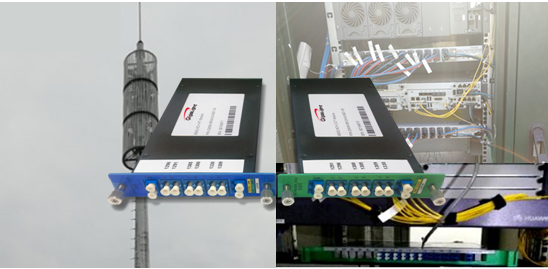
Next-Generation Data Center: AOC or DAC?
The growing role of clouds in data communications of all kinds with the consequent growth of hyperscale data centers, small moves towards 400Gbps deployment. There are some debates about which one is optimal for the Next-Generation Data Center (NGDC)? AOC or DAC?
First, how well do you know the optimal high-speed optical solutions for NGDC?
- Distance
- Cost
- Power consumption
- Cable weight
- Density
- Latency
DAC
DAC, short for Direct Attach Cable, is used to connect one mobility access switch with another when forming a stack. DAC can be either Passive Copper Cable (PCC) or Active Copper Cable (ACC).
AOC
AOC, short for Active Optical Cable, is an alternative to optical transceivers. It eliminates the separable interface between the transceiver module and optical cable and offers a number of advantages over DAC. Here is a picture of AOC as following.
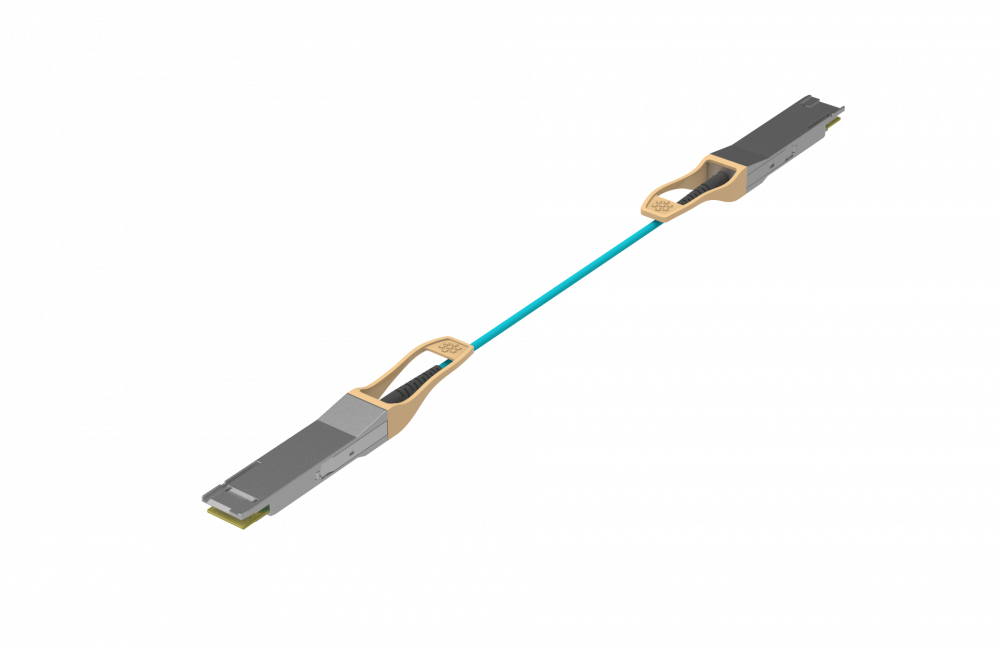
AOC vs. DAC
- AOC features longer distance—DAC up to 15m; AOC up to 300m.
- DAC is cheaper than AOC.
- DAC features lower power consumption than AOC.
- AOC features lower cable weight than DAC.
- DAC and AOC offer the same density.
- AOC features lower latency than DAC.
Conclusion
As the development of optical communication technologies, it is said that the optics will replace copper in the future. Thought I don't think so, there is no doubt that AOC is becoming the mainstream solution for NGDC owing to its advantages. AOC will have a greater potential than DAC in the deployment of NGDC.
A few years ago, the largest data centers would never have bought Chinese AOCs fearing that they would be low quality. There are data center managers who worry about such things and are very rigid about specs when it comes to components such as AOCs. However, with the development of optical communication market in recent years, the whole AOC business is shifting to China. We expect that the differences between the U.S. and Chinese firms are eroding when it comes to quality. As one of the best Chinese firms, Gigalight is respectable in the AOC market. In 2019, Gigalight can offer 200Gbps and even 400Gbps AOCs.
Analysis of the Current Coherent Optical Module Market
Researchers have made great progress in optical devices. The output power of laser, linewidth, stability and noise, as well as the bandwidth of photodetectors, power capacity and common mode rejection ratio have been greatly improved. Microwave electronic devices have also been greatly improved. Then, the coherent optical communication technology has gradually become an important capacity-lifting solution for the current 100G line-side.
Market Demand for Coherent Optical Communication
One of the biggest drivers of growth in the current communications market is the transition from 10G to 100G in the metro, core and Data Center Interconnect (DCI) sectors.
With the explosive growth of information generated by the use of communication technologies such as video conferencing and the spread of the Internet, the market has proposed higher transmission performance requirements for the physical layer that is the basis of the entire communication system.

In terms of digital communication, how to expand the capacity of C-band amplifiers, overcome the deterioration of fiber dispersion effects, and increase the capacity and range of free-space transmission have become important considerations for researchers; in analog communication, sensitivity and dynamic range are key parameters of systems.
Driven by strong demand, large-scale DWDM systems are gradually depleting their wavelength resources, and the efficiency of Time-Division Multiplexing (TDM) systems through compressed optical pulses also has a large technical bottleneck. People began to consider replacing the original Wavelength Division Multiplexing (WDM) system with a coherent optical communication system.
Advantages of Coherent Optical Modules
The coherent optical communication system modulates the signal to the optical carrier by adjusting the amplitude, phase and frequency by means of external light modulation (such as DP-QPSK) at the transmitting end.
Compared with the traditional direct detection system, coherent detection can obtain more signal information through the signal light and the beat frequency of the local oscillator; after the signal reaches the receiving end, it uses high-speed Digital Signal Processing (DSP) technology to perform front-end processing such as equalization. The optical mixer and the optical signal generated by the local oscillator are coherently mixed to realize signal reconstruction and distortion compensation.

Coherent optics can be used in both 100G and 400G applications, primarily because it enables service providers to send more data over existing fiber, reducing the cost and complexity of network upgrades for bandwidth expansion.
- Coherent detection combined with DSP technology:
- Cleared barriers to traditional coherent reception
- Compensate for various transmission impairments in the electrical domain, simplifying transmission links
- Make high-order modulation formats and polarization states possible
- At the same time, the application of high-order modulation formats enables coherent optical communication to have higher single-wavelength channel spectrum utilization compared to traditional system systems.
Coherent receivers have no special requirements for fiber channel, so coherent optical communication can use already laid fiber lines. With the aid of digital signal processing algorithms, coherent receivers compensate for signal distortion caused by fiber dispersion, polarization mode dispersion, and carrier phase noise at a very small cost. - A coherent receiver is about 20 dB more sensitive than a normal receiver, so the distance that is not relayed in the transmission system becomes longer, which reduces the number of amplifications in the transmitted light path.
Based on the above reasons, coherent optical communication can reduce the cost of optical fiber erection for long-distance transmission, simplify optical path amplification and compensation design, and become the main application technology of current long-distance transmission network.
Application Scenarios of Coherent Optical Modules
At present, the coherent optical communication is mainly used on the line side of the backbone network and the metropolitan area network, and belongs to the technical research field of DWDM long-distance transmission. In the application scenarios of the metropolitan area network and the core network with distance more than 80km, the coherent optical communication features good performance of Optical Signal-to-Noise Ratio (OSNR), sensitivity, dispersion tolerance and so on.
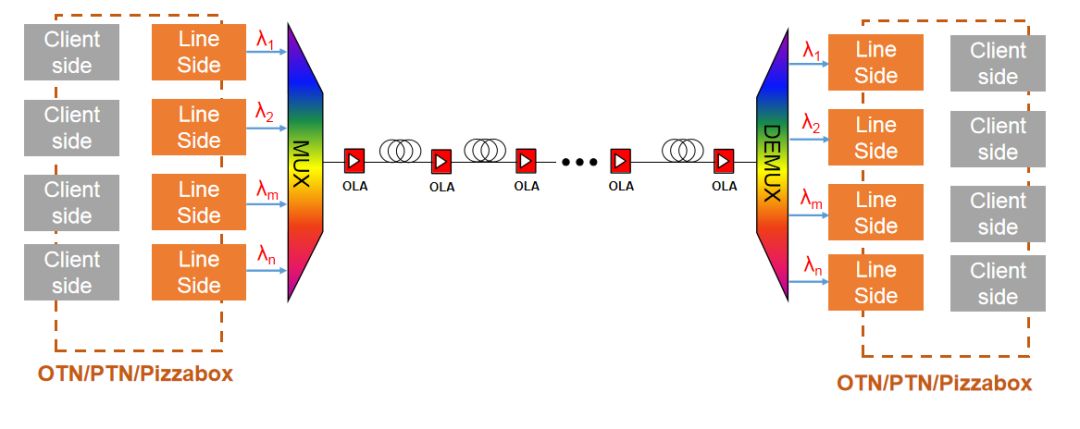
WDM System
The operating wavelength range is C-band (1530nm to 1565nm), and the fiber type is G.652D (prefered) or G.655. The key performance index is OSNR.
Error correction coding technology can jump out of the limitations of the physical layer of transmission, and compensate for all physical transmission impairments at the logic layer, especially the effects of nonlinear effects.

5G Middlehaul/Backhaul Network
In the 5G middlehaul scenario, 100G/200G DWDM system will be deployed, and the 100G CFP-DCO and 200G CFP2-DCO optical module can be used to implement the 80km scene application; the 400G DCO product is applied in the 5G backhaul scenario with distance less than 200km.
DCI
Whether the coherent communication will be used in the DCI field of 40km to 80km depends mainly depends on the commercial cost performance and whether the market capacity is large enough.
At the current 100G rate, products such as 100G ER with EML modulation are sufficient for the use; the 100G CFP-DCO ZR series will appear in the future.
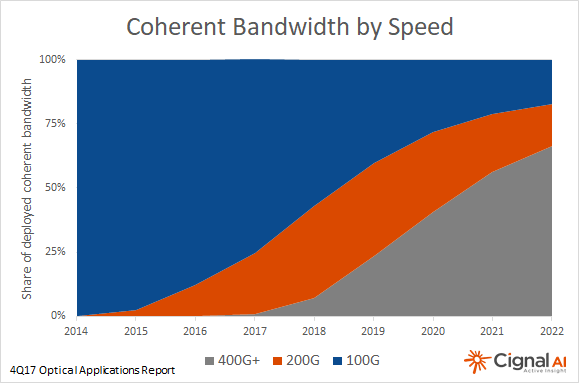
The OIF organization is developing a 400ZR specification that uses a combination of DWDM and coherent technology.
Andrew Schmitt, principal analyst at Cignal AI, said: "Coherent 400G will limit the development of existing 200G and 100G technologies by 2020, and new devices will maximize optical capacity without relying on coverage." Foreseeable Yes, more and more 400ZR products will enter the market.
Summary
The coherent optical communication system is a more advanced and complex optical transmission system suitable for longer distance and larger capacity information transmission.
At present, coherent modules with the CFP form-factor are bulky and consume large power. Compact coherent modules will replace existing coherent products. The innovation of semiconductor technology and the improvement of chip technology will greatly promote the replacement of 400G coherent products.
In recent years, Gigalight, a global optical interconnect innovator, has increased its research and development of coherent modules and has achieved a series of achievements. In the next few years, it will strengthen cooperation with the industry and jointly promote the progress of related industries.
Source: Analysis of the Current Coherent Optical Module Market
What Is the DSP in Coherent Optical Modules?
As a leader of optical interconnection design, Gigalight has completed the R&D of 100G CFP-DCO coherent optical modules and successfully solved the 80km+ application on the line side. This is an important step for Gigalight in the Metropolitan Area Network (MAN) transmission solutions. You should know that, In China, there are few companies in the industry that can provide coherent optical modules.
While the Digital Signal Processing (DSP) technology is a key part in coherent optical modules, this paper introduces the role of DSP and its application prospects.
Coherent Technology
In the distant 1980s, scientists studying ultrafast optical communications began to study coherent optical communications. The advantages of coherent transmission are obvious: high sensitivity (suitable for long-haul transmission) and large bandwidth. However, in the 1990s, technologies such as Erbium-Doped Fiber Amplifier (EDFA) and Wavelength Division Multiplexing (WDM) debuted, replacing the original advantages of coherent transmission. Coherent technology has since been broken into the cold.
Luckily, coherent technology has not been buried in this way. In the current metro optical interconnect system, large-scale DWDM systems are gradually depleting their wavelength advantages, and there is a big technical bottleneck to improve the efficiency of Time-Division Multiplexing (TDM) systems by compressing optical pulses. How to do it? The younger brothers can't do it. It seems that they still have to rely on big brother. So, the coherent optical communication system has once again returned to the stage.
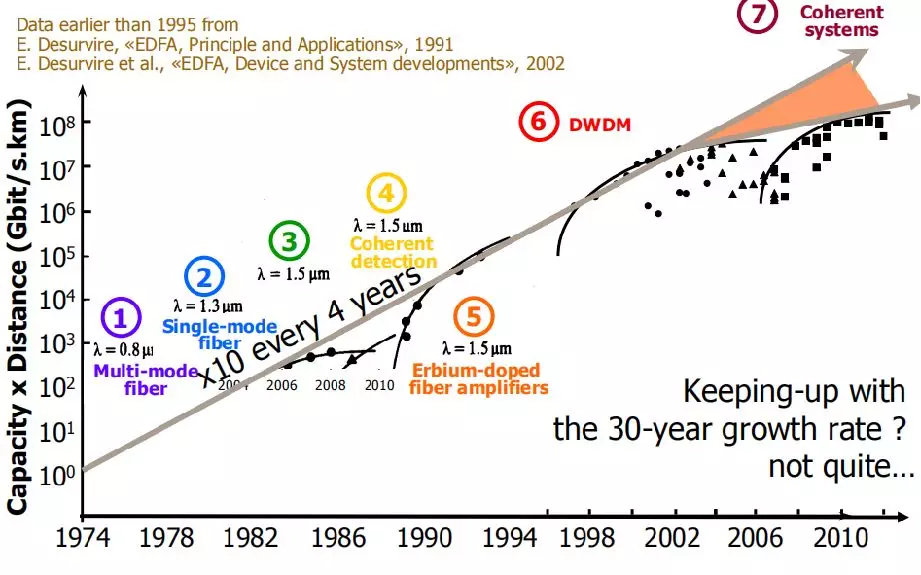
History of Transmission Technologies
For example, Gigalight's 100G CFP-DCO optical module is the result of research under new historical opportunities. The 100G coherent optical module belongs to the technical research field of long-distance transmission of 100G DWDM. It is mainly used for line-side optical transmission of 100G WDM system. Compared with other various forms of line-side optical modules, it features good OSNR performance, sensitivity, dispersion tolerance, and DGD tolerance, making it one of the best choices in the industry.
The Main Role of DSP
The key technologies of the coherent transmission system mainly include DP-QPSK, coherent detection and DSP high-speed digital processing. Except for the DSP link, most of them use commercial devices; if they are not purchasing particularly poor device products, the performance of each family is similar. The final impact on the final performance is in the DSP segment, and various manufacturers have adopted different patent algorithms.
High-Speed DSP Chips
- For dispersion compensation
- To remove noise, nonlinearity and other interference factors
- To provide digital clock recovery
- To restore the 100G signal from the transmitter
In general, the following three problems have been solved:
- High-order modulation formats to improve spectral efficiency
- Transmission effects of devices and signal channels
- Signal-to-Noise Ratio (SNR) issues

DSP Processing Data
The DSP has related processing on the client side and the line side, and has a framer inside, which can perform deframing and framing processing according to the G.709 protocol.
The Structure of DSP
What is the specific structure of the DSP? The DSP in the field of optical communication generally consists of several parts:
- Front-end analog-digital mixing
- Digital-to-Analog Converter (DAC)
- Analog-to-Digital Converter (DAC)
- Serdes
- Digital signal processing section
- FEC
- PHY section
Analog Digital Mixing
The main function of the ADC and DAC is to convert between analog and digital signals, which is the bridge between the modulation device and the digital signal processing part. The ADC and DAC are mainly composed of four key indicators:
- Sample rate
- Sampling effective bit width
- Analog bandwidth
- Power consumption
Among them, analog bandwidth is the main technical challenge, and under the condition of using DSP, the bandwidth limitation of general system is no longer optical device, but ADC and DAC.
Digital Signal Processing Unit
Digital data processing units are relatively simple to use within the data center.
For example, for the 100G PAM4 application, the spectrum compression, nonlinear compensation, FEC encoding, etc. of the transmitted signal are mainly completed at the originating end, and the signal is compensated by using an adaptive filter after the receiving ADC.
In the digital signal processing unit, the FIR filter is generally used to compensate the signal. The design of the FIR filter's tap number and the decision function directly determines the performance and power consumption of the DSP.
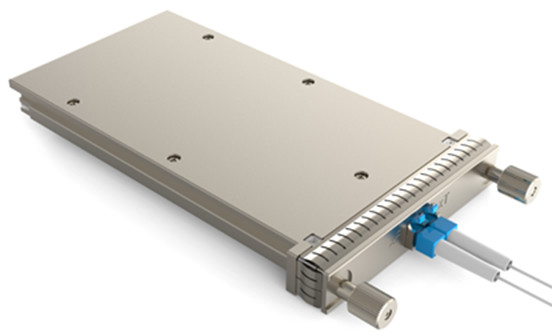
Gigalight 100G CFP-DCO Coherent Optical Module
The Power Consumption and Cost Issues of DSP
There is no doubt that DSP has increased power consumption while improving performance. Because DSP introduces DAC/ADC and algorithm, its power consumption must be higher than traditional CDR chip based on analog technology.
At present, the design power of the 400G OSFP/QSFP-DD based on the 16nm DSP solution is about 12W, which is a huge challenge for the module itself or the panel thermal design of the future switch.
In addition, the cost is always a topic of concern to data centers and 5G operators. Unlike traditional optical devices, for DSP chips, due to mature semiconductor technology, large chip cost reduction can be expected under the support of massive applications. space.
Summary
Due to the technical advantages (bandwidth and sensitivity), coherent optical modules will be of great use in the future optical communications market. As the most important part of the coherent optical module, DSP has many functions, including DAC/ADC sampling, frame matching and detection, differential decomposition coding, pulse shaping, clock data recovery and polarization equalization. In recent years, Gigalight has established the Wuhan R&D Center, attaches great importance to the cultivation of talents, and has achieved a series of leading results in the research of coherent modules.
Original article: What Is the DSP in Coherent Optical Modules?
Gigalight 100G Optical Modules Passed the Connectivity Test of Multiple Cloud Service Providers
Shenzhen, China, May 19, 2018 – Gigalight announced the 100G series optical transceiver modules have passed the connectivity test of multiple cloud service providers. The Gigalight 100G series products include 100G QSFP28 SR4 multi-mode VCSEL optical modules and 100G QSFP28 CWDM4 single-mode WDM optical modules. The interconnection test covers the mainstream cloud devices of major brand equipment vendors and the optical transceiver module products of our partners.

Qualified 100G Series Optical Transceiver Modules
Gigalight has always been among the top 10 companies in the world of optical interconnects with its invention of active optical cables and deep innovation. However, Gigalight is essentially an integrated solution provider of optical transceiver modules and optical network devices. Gigalight ships a large number of 10G multimode and 10G single-mode optical modules and 40G multimode SR4 optical modules to the world. In the field of 40G single-mode optical modules, Gigalight's main customers include global TIE1 equipment vendors. The cloud service providers have directly verified Gigalight's 100G optical modules since the end of 2017. The successful interconnection results so far have greatly encouraged Gigalight's confidence in deploying 100G optical modules in bulk in the cloud.

Global Data Center Infrastructure Ecosystem
Gigalight has a deep optical interconnect product line. Among this product line, the multimode optical interconnect products based on the VCSEL technology applications are the traditional advantages of Gigalight, including the cost-effective and reliable 100G QSFP28 SR4 optical modules with good compatibility. The single-mode 100G series short-range optical modules were developed in 2016 and this time passed the threshold of full-brand compatibility and interoperability testing after optical design thresholds and reliability verification thresholds. Finally, they will not lose pace in the industry's striding forward in 2018.
As a global optical interconnect design innovator, Gigalight has prepared the best 100G optical modules for industry users.
About Gigalight:
Gigalight is a global optical interconnection design innovator. We design, manufacture and supply various kinds of optical interconnect products including optical transceivers, passive optical components, active optical cables, GIGAC™ MTP/MPO cablings, and cloud programmers & checkers, etc. These products are designed for three main applications which are Data Center & Cloud Computing, Metro & Broadcast Network, and WIreless & 5G Optical Transport Network. Gigalight takes the advantages of exclusive design to provide customers with one-stop optical network devices and cost-effective products.
What is Data Center Interconnect/Interconnection?
Data Center Interconnection means the implements of Data center Interconnect (DCI) technology. With the DCI technology advances, better and cheaper options have become available and this has created a lot of confusion. This is compounded by the fact that a lot of companies are trying to enter this market because there is a lot of money to be made. This article is written to straighten out some of the confusion.
According to the different applications, there are two parts of data center interconnections. The first is intra-Data Center Interconnect (intra-DCI) which means connections within the data center. It can be within one building or between data center buildings on a campus. Connections can be a few meters up to 10km. The second is inter-Data Center Interconnect (inter-DCI) which means connections between data centers from 10km up to 80km. Of course, connections can be much longer but most of the market activity for inter-DCI is focused on 10km to 80km. Longer connections are considered Metro or Long-haul. For reference, please see the table below.
| DCI | Distance | Fiber Type | Optics Technology | Optical Transceivers |
| intra-DCI | 300m | MMF | NRZ/PAM4 | QSFP28 SR4 |
| 500m | SMF | QSFP28 PSM4 | ||
| 2km | QSFP28 CWDM4 | |||
| 10km | QSFP28 LR4 | |||
| inter-DCI | 10km | SMF | Cohernet | QSFP28 4WDM-10 |
| 20km | QSFP28 4WDM-20 | |||
| 30km to 40km | QSFP28 4WDM-40 | |||
| 80km to 2000km | CFP2-ACO |
Intra-DCI
The big bottlenecks are in the intra-DCI and therefore, the highest volume of optical transceivers are sold here generating the most revenue, however, it is low margin revenue because there is so much competition. In this space, may of the connections are less than 300m and Multi-Mode Fiber (MMF) is frequently used. MMF is thicker, and components are cheaper because the tolerances are not as tight, but the light disperses as it bounces around in the thick cable. Therefore, 300m is the limit for many types of high speed transmission that use MMF. There is a data center transceiver with a transmission distance up to 100m over OM4 MMF for example.
100G QSFP28 SR4 for MMF up to 100m
In a data center, everything is connected to servers by routers and switches. Sometimes a data center can be one large building bigger than a football field and other times data centers are built on a campus of many buildings spanning many blocks. In the case of a campus, the fiber is brought to one hub and the connections are made there. Even if the building you want to connect to might be 200m away, the fiber runs to a hub, which can be more than 1km away, so this type of routing increases the fiber distance. Some of the distances between buildings can be 4km, requiring Single Mode Fiber (SMF), which has a much narrower core, making it more efficient, but also increasing the cost of all related components because the tolerances are tighter. Therefore, with data centers growing, so has the need for SMF as the connections get longer within the data center. With SMF you have the option to drive high bandwidth with coherent technology, and we'll see more of this in the future. Previously coherent was only used for longer distances, but with cost reductions and greater efficiency versus other solutions, coherent is now being used for shorter reaches in the data center.
100G QSFP28 LR4L for SMF up to 4km
500m is a new emerging market and because the distance is shorter, a new technology is emerging, and that is silicon photonics modulators. EMLs (Externally Modulated Lasers) perform modulation within the laser, but with silicon photonics, the modulator is outside the laser and it's a good solutions for distances of 500m. In an EML, the modulator is integrated into the same chip, but is outside the laser cavity, and hence is "external". For silicon photonics, the laser and modulator are on different chips and usually in different packages. Silicon photonics modulators are based on the CMOS manufacturing process that is high scale and low cost. A continuous wave laser with silicon photonic modulation is very good for 500m applications. EMLs are more suitable for longer reaches, such as 2-10km. Therefore, with data centers growing, so has the need for single mode fiber as the connections get longer within the data center. With SMF you have the option to drive high bandwidth with coherent technology, and we'll see more of this in the future. Previously coherent was only used for longer distances, but with cost reductions and greater efficiency versus other solutions, coherent is now being used for shorter reaches in the data center.
100G QSFP28 PSM4 for SMF up to 500m/2km
100G QSFP28 CWDM4 for SMF up to 2km
100G QSFP28 LR4 for SMF up to 10km
Inter-DCI
Inter-DCI is typically between 10km and 80km, including 20km and 40km. Before we talk about data center connectivity, let's talk about why data centers are set up the way they are and why 80km is such an important connection distance. While it is true that a data center in New York might backup to tape in a data center in Oregon, this is considered regular long-haul traffic. Some data centers are geographically situated to serve an entire continent and others are focused on a specific metro area. Currently, the throughput bottleneck is in the metro and this is where data centers and connectivity are most needed.
100G QSFP28 4WDM-20 for SMF up to 20km
100G QSFP28 4WDM-40 for SMF up to 40km
Say you have a Fortune 100 retailer and they are running thousands of transactions per second. The farther away a data center is, the more the data is secure because the data center is so far away and separate from natural disasters, but with the increased distance there are more "in flight" transactions are at risk of being lost due to latency. Therefore, for online transactions there might be a primary data center that is central to retail locations and a secondary data center that is around 80km away. It's far enough away not to be affected by local power outages, tornadoes, etc, but close enough that there is only a few hundred milli-seconds of latency; therefore, in the worst case a small number of transactions would be at risk.
In another example of inter-DCI, as if a certain video is getting a lot of views, the video is not only kept in its central location, but copies of the video are pushed to metro data centers where access is quicker because it's stored closer to the user, and the traffic doesn't tie up long haul networks. Metro data centers can grow to a certain size until their sheer size becomes a liability with no additional scale advantage and thus they are broken up into clusters. Once again, to guard against natural disasters and power outages, data centers should be far away. Counterbalancing this, data centers need to have low latency communication between them, so they shouldn't be too far away. There is a compromise and the magic distance is 80km for a secondary data center, so you'll hear about 80km data center interconnect a lot.
It used to be that on-off keying could provide sufficient bandwidth between data centers, but now with 4K video and metro bottlenecks, coherent transmission is being used for shorter and shorter distances. Coherent is likely to take over the 10km DCI market. It has already taken over the 80km market but it might take time before coherent comes to 2km. The typical data center bottlenecks are 500m, 2km, and 80km. As coherent moves to shorter distances, this is where the confusion comes.
The optical transceiver modules that were only used within the data center are gaining reach, and they're running up against coherent solutions that were formerly only used for long distances. Due to the increasing bandwidth and decreasing cost, coherent is being pulled closer into the data center.
The other thing to think about is installing fiber between data centers. Hopefully this is already done, because once you dig, it's a fixed cost, so you put down as many fibers as you can. Digging just for installing fiber is extremely expensive. In France when they lay fiber, they use another economic driver. Whenever you put in train tracks, you put in fiber at the same time, even if it is not needed. It's almost for free because they are digging anyway. Fibers are leased to data centers one at a time; therefore, data centers try to get as much bandwidth as possible onto each fiber (this is also a major theme in the industry). You might ask, why not own your own fiber? You need to have a lot of content to own your own fiber. The cost is prohibitive. In order to make the fiber network function, all the nodes need to use the same specification and this is hard. Therefore, carriers are usually the ones to install the full infrastructure.
Article Source: John Houghton, a Silicon Valley entrepreneur, technology innovator, and head of MobileCast Media.
Gigalight's First Successful Project for the Russian ISP Market Based on GIGAC™ Cabling
Shenzhen, China, May 9, 2018 − The Gigalight's GIGAC™ MTP/MPO Cabling Portfolio has won the first big order in the Russian ISP market. In the next three years, Gigalight will provide the largest Russian Internet service provider with the GIGAC™ high-density cabling products for the data centers in major Russian cities.
Data centers are very important for modern large IT business units. As the largest Internet service provider in Russia, this client has its own data centers with the major target to optimize the network and improve the quality of the business. On the picture below, the right is the previous organization of the racks and on the left is the current installation.

The Gigalight company together with the expertise partner in Russia have solved this challenge and ensured the reliability for the current network.


Almost the full range of Gigalight optical transceivers and GIGAC™ cabling products, including GIGAC™ MTP/MPO patch cables, trunk cables, harness cables, hydra cables, GIGAC™ racks and cassettes are used in this project. They are particularly reliable and safe, and can withstand temperatures up to 70 °C. Typical uses for the cables include delivering optimal performance and data transmission for information systems.

This order follows after the years of the hard work with the Russian market. Well-known companies, public and private operators of data and communications networks are placing their trust in Gigalight’s expertise for years. Their confidence is based on our powerful cabling solutions, optical transceivers manufacturing capacity, and the tireless support we provide to our customers.
Gigalight is the world's design innovator in the optical interconnect field and this order sees it continue to build on this strong position. The company has rich experience in the development and production of optical transceivers, GIGAC™ MTP/MPO cables and passive optical components. In addition to connectivity solutions for the interconnect field, Gigalight also develops checkers and programming boards for the production lines, data centers and our global partners.
About Gigalight:
Gigalight is global optical interconnection design innovator. A series of optical interconnect products include: optical transceivers, passive optical components, active optical cables, GIGAC™ MTP/MPO cablings, and cloud programmers & checkers, etc. Three applications are mainly covered: Data Center & Cloud Computing, MAN & Broadcast Video, and Mobile Network & 5G Optical Transmission. Gigalight takes advantage of its exclusive design to provide clients with one-stop optical network devices and cost-effective products.
Article Source: http://www.gigalight.com/news_detail/newsId=438.html




